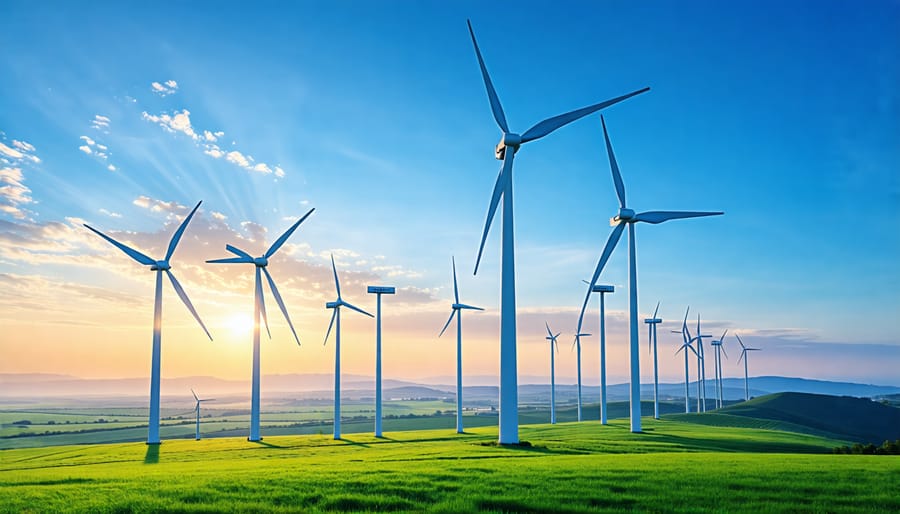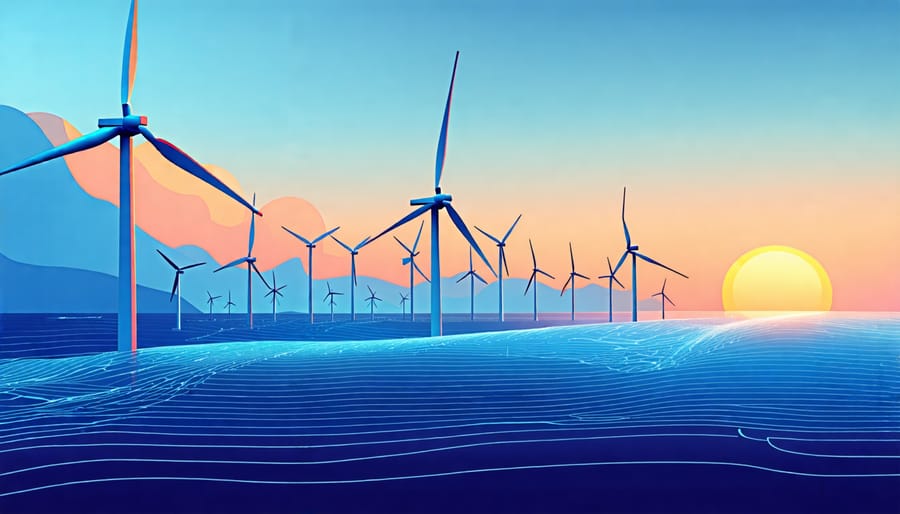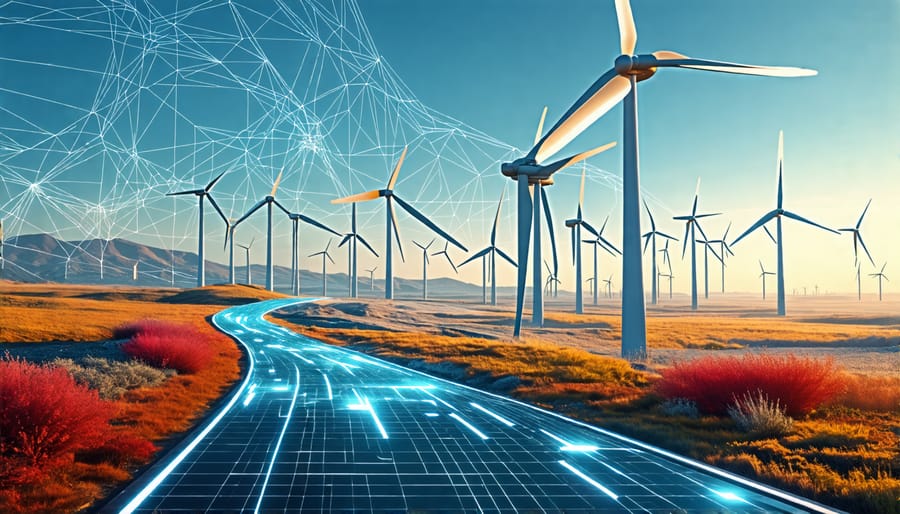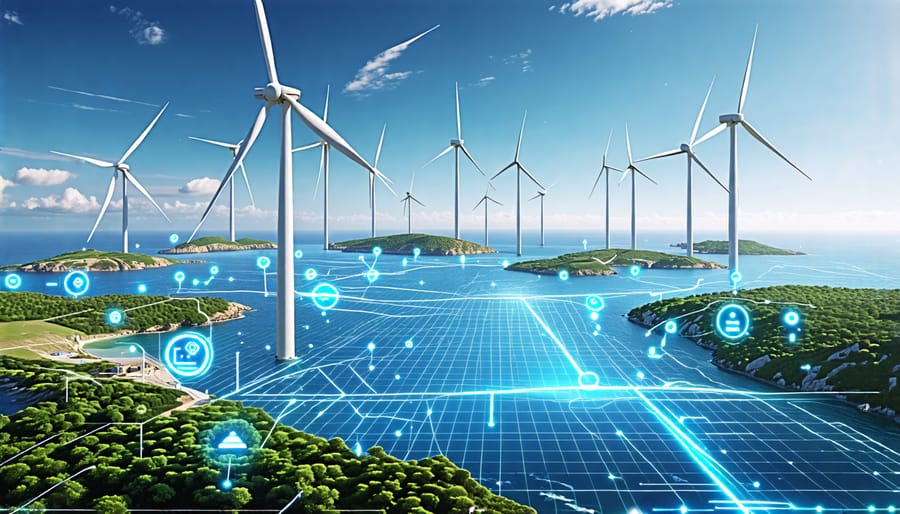Explore the transformative potential of wind turbines by embracing cutting-edge technologies such as vertical-axis models and floating offshore designs to capture higher wind speeds and enhance energy efficiency. Optimize turbine performance by integrating smart grid systems, enabling real-time data analysis to maximize output and predict maintenance needs. Mitigate environmental impacts by employing bird-safe designs and materials that minimize disruption to local ecosystems. Facilitate economic growth by investing in community-owned wind farms, creating sustainable jobs and fostering energy independence. Discover the intricate wind power function to deepen your understanding of the complex mechanics driving these innovations.
The Evolution of Wind Turbine Technology

Key Technological Advancements
Recent technological advancements in wind turbines have significantly enhanced their efficiency and sustainability. One of the key developments is the innovation in blade design. New aerodynamic shapes, inspired by the wing formations of birds, reduce drag and increase energy capture, even at low wind speeds. This is complemented by the integration of smart sensors and IoT technology that enable real-time monitoring, allowing turbines to swiftly adapt to changing wind conditions and optimize performance.
Another major breakthrough is the use of advanced materials like carbon fiber composites. These materials are not only lighter but also more robust, extending the lifespan of turbines while lowering maintenance costs. Furthermore, floating wind farms represent a transformative approach, enabling the installation of turbines in deep sea locations with stronger and more consistent wind patterns. This innovation opens vast new areas for energy generation without impacting terrestrial habitats.
By harnessing these cutting-edge technologies, the future of wind energy looks promising, offering a cleaner, more sustainable power source that can meet global energy demands.
Case Study: Successful Installations
One standout example of cutting-edge wind turbine installation is the Hornsea Project One in the UK, the world’s largest offshore wind farm. Completed in 2020, it boasts 174 turbines, providing clean energy to over one million homes. This groundbreaking project not only demonstrates the feasibility of large-scale renewable energy solutions but also underscores the economic potential of such initiatives, having created thousands of local jobs during construction and ongoing maintenance.
Another remarkable installation is the Block Island Wind Farm located off the coast of Rhode Island, USA, which became operational in 2016. As the first offshore wind farm in the United States, it set a precedent for future developments across the country. Despite initial skepticism, the project has exceeded expectations in electricity generation and has eradicated the island’s dependency on diesel generators, significantly reducing its carbon footprint.
Projects like these highlight the promising future of wind energy, showcasing how advanced technology and strategic implementation can lead to significant environmental and economic benefits.
Future Trends and Innovations

Offshore Wind Farms
The rise of offshore wind farms marks a significant shift in the renewable energy landscape, harnessing the powerful and consistent winds over the oceans to generate electricity. These installations offer several advantages over their land-based counterparts. For starters, offshore wind farms can be built with larger turbines and taller towers, benefiting from unobstructed wind flows and resulting in higher energy outputs. This means that a single offshore turbine can produce more energy compared to an onshore one, making them an incredibly efficient option.
Moreover, the environmental impact of offshore wind farms is often less contentious. While large land-based wind farms can face local opposition due to noise and aesthetic concerns, their offshore variants are typically located far from populated areas, minimizing disruptions to daily life. This distance from residential zones also allows for the deployment of larger projects without the same level of scrutiny.
Real-world examples, such as the Hornsea One project off the coast of England, showcase the potential of such ventures. Upon completion, it became the largest offshore wind farm worldwide, capable of powering over a million homes. Expert interviews also highlight the economic benefits, with these projects creating a significant number of jobs within the renewable sector.
As technology advances and costs continue to decrease, offshore wind farms are poised to play a pivotal role in achieving global energy goals while combating climate change. This optimism is backed by both empirical data and industry forecasts, illustrating that the future of offshore wind energy is not only promising but essential.
AI and Smart Turbines
The integration of artificial intelligence (AI) with wind turbines marks a significant leap forward in optimizing their performance and maintenance. With the latest innovations in technology, AI empowers turbines to operate more efficiently by predicting wind patterns and adjusting blades for maximum energy capture. This intelligent adaptation not only increases energy output but also extends turbine lifespan by reducing unnecessary wear and tear.
One remarkable real-world case comes from a Danish wind farm, where AI algorithms analyze data from weather forecasts and turbine sensors to optimize energy production. This predictive capability ensures renewable energy is delivered consistently to the grid, cementing wind’s role as a reliable power source.
Furthermore, AI in renewable energy enables proactive maintenance strategies by identifying potential failures before they occur. Drones equipped with AI-driven image analysis inspect turbine blades, detecting micro-cracks invisible to the human eye. This early detection prevents costly downtimes and minimizes environmental impact.
These cutting-edge applications of AI in wind energy not only enhance performance and reduce operational costs but also demonstrate a compelling step towards a greener future, showcasing how technology can harmonize with nature for sustainable energy solutions.

Environmental and Economic Implications
Reduced Environmental Footprint
As the future of wind turbines unfolds, significant advancements are set to dramatically reduce their environmental footprint. Emerging technologies, such as biodegradable turbine materials and more efficient recycling processes, promise to enhance sustainability from production to decommissioning. For instance, a new wave of research focuses on blade designs using natural fibers and resins, significantly mitigating waste issues and minimizing reliance on fossil fuel-based materials.
Furthermore, innovative site planning and predictive maintenance technologies are reducing land impact and operational energy use. By leveraging big data and AI, operators can optimize turbine placements and maintenance schedules, ensuring minimal disturbance to local ecosystems. Real-life cases, like projects in Denmark, showcase how implementing these technologies has cut maintenance time by 50%, reinforcing the ecological and economic benefits.
With wind power predicted to cover a wider share of global energy demands, the pursuit of green innovations continues to shine as a beacon of hope. These advancements not only align with environmental goals but also bolster the push towards a more sustainable and energy-efficient future.
Economic Opportunities
Wind turbines present significant economic benefits for communities and industries that embrace them. As demand for renewable energy sources grows, regions investing in wind power see the potential for robust economic growth and job creation. For example, rural areas with abundant wind resources benefit from stable lease payments to landowners and increased local tax revenues. This can fund schools, infrastructure, and community services, enriching the quality of life and fostering a thriving local economy.
Industries focused on manufacturing and maintaining wind turbines experience job growth across various skill levels, providing high-tech and blue-collar opportunities alike. Moreover, experts anticipate that advancements in wind turbine technology, such as improved efficiency and storage capabilities, will drive down costs, making wind energy more competitive with conventional energy sources. This shift represents a sustainable economic transition, encouraging investment and innovation in green technologies while promoting energy independence, ultimately contributing to a more resilient and sustainable future.
Expert Insights
Interview with Industry Leader
In a captivating discussion with Emily Larsen, a leading figure in the wind energy sector and CEO of GreenWind Innovations, we explored the transformative potential of wind turbine technology in shaping a sustainable future. Larsen shared her insights on key advancements propelling the industry forward. One major trend she highlighted is the development of floating offshore wind farms, which promise to unlock vast new areas for wind energy without the constraints of ocean depth previously limiting turbine installations.
Larsen also emphasized the role of digitalization and AI in optimizing wind farm operations. These technologies allow for real-time monitoring and predictive maintenance, significantly boosting efficiency and lifespan while reducing costs. As she noted, “The integration of AI enables us to harness the power of data, making wind energy more reliable and cost-effective than ever before.”
Environmental impact remains a focal point, and Larsen pointed out ongoing efforts to mitigate issues such as noise pollution and wildlife disruption. Innovations in turbine blade design are not only enhancing performance but are also engineered with sustainability in mind, using recyclable materials to address the end-of-life disposal challenge.
On the economic front, Larsen predicted that continued advancements and scaling of wind technology will drive down costs, making it an increasingly attractive option for countries transitioning to renewable energy. She concluded optimistically, “With the commitment of researchers and engineers worldwide, the future of wind energy is not just promising but essential for a sustainable planet.” This conversation underscores the dynamic evolution of wind turbines, highlighting their pivotal role in the green energy landscape.
Conclusion
As we conclude our exploration of wind energy, it’s clear that this renewable resource holds significant promise for the future of sustainable energy. Through the innovative designs of modern wind turbines and the progressive policy frameworks slowly being adopted worldwide, we’ve witnessed the ability of wind power to reshape our energy landscape. Real-life case studies have shown us communities that have embraced wind energy, not only reducing their carbon footprint but also reaping the economic benefits of job creation and energy cost savings.
Experts in the field have shared optimistic insights, underscoring that with continued technological advancements, such as improved turbine efficiency and better energy storage solutions, the potential of wind energy is vast. These innovations promise to make wind power more accessible and effective, capable of meeting a significant portion of our energy needs.
Furthermore, as public awareness about climate change grows, there is a surging demand for environmentally sound solutions like wind energy. This aligns perfectly with global sustainability goals and hints at an exciting era where renewable energy will play a pivotal role in our daily lives. By fostering collaboration between policymakers, industries, and communities, we can harness the full potential of wind energy, driving us toward a cleaner, more sustainable future.





